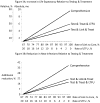Comparative effectiveness of HIV testing and treatment in highly endemic regions
- PMID: 20696960
- PMCID: PMC2921232
- DOI: 10.1001/archinternmed.2010.249
Comparative effectiveness of HIV testing and treatment in highly endemic regions
Abstract
Background: Universal testing and treatment holds promise for reducing the burden of human immunodeficiency virus (HIV) in sub-Saharan Africa, but linkage from testing to treatment sites and retention in care are inadequate.
Methods: We developed a simulation of the HIV epidemic and HIV disease progression in South Africa to compare the outcomes of the present HIV treatment campaign (status quo) with 4 HIV testing and treating strategies that increase access to antiretroviral therapy: (1) universal testing and treatment without changes in linkage to care and loss to follow-up; (2) universal testing and treatment with improved linkage to care; (3) universal testing and treatment with reduced loss to follow-up; and (4) comprehensive HIV care with universal testing and treatment, improved linkage to care, and reduced loss to follow-up. The main outcome measures were survival benefits, new HIV infections, and HIV prevalence.
Results: Compared with the status quo strategy, universal testing and treatment (1) was associated with a mean (95% uncertainty bounds) life expectancy gain of 12.0 months (11.3-12.2 months), and 35.3% (32.7%-37.5%) fewer HIV infections over a 10-year time horizon. Improved linkage to care (2), prevention of loss to follow-up (3), and comprehensive HIV care (4) provided substantial additional benefits: life expectancy gains compared with the status quo strategy were 16.1, 18.6, and 22.2 months, and new infections were 55.5%, 51.4%, and 73.2% lower, respectively. In sensitivity analysis, comprehensive HIV care reduced new infections by 69.7% to 76.7% under a broad set of assumptions.
Conclusions: Universal testing and treatment with current levels of linkage to care and loss to follow-up could substantially reduce the HIV death toll and new HIV infections. However, increasing linkage to care and preventing loss to follow-up provides nearly twice the benefits of universal testing and treatment alone.
Conflict of interest statement
Author Contribution and Conflicts of Interest (Author Form Submitted Separately)
Eran Bendavid:
I participated in originating the concept, in conducting the data collection, construction of the model, and data analysis. I did most of the writing of the paper, including the final revision. I had full access to all of the data in the study and I take responsibility for the integrity of the data and the accuracy of the data analysis. I have no conflicts of interest.
Margaret L. Brandeau:
I participated in elucidating the project’s concept, in conceptualizing the model structure, and revising the manuscript. I have seen and approved the final version and I have no conflicts of interest.
Robin Wood:
I participated in defining the project’s concept, in clarifying issues relating to HIV testing and treatment in South Africa, and in revising the manuscript. I have seen and approved the final version and I have no conflicts of interest.
Douglas K. Owens:
I participated in defining the original concept, in conceptualizing the model, in advising on issues related to outcomes analysis, and in writing and revising the manuscript. I have seen and approved the final version, and I have no conflicts of interest.
Figures



Comment on
-
"A bird in the hand...": a commentary on the test and treat approach for HIV.Arch Intern Med. 2010 Aug 9;170(15):1354-6. doi: 10.1001/archinternmed.2010.248. Arch Intern Med. 2010. PMID: 20696961 No abstract available.
References
-
- UNAIDS. Report on the Global AIDS Epidemic. Geneva: Joint United Nations Programme on HIV/AIDS; 2008.
-
- UNAIDS. AIDS Epidemic Update. Geneva: Joint United Nations Programme on HIV/AIDS; 2007.
-
- Gregson S, Garnett GP, Nyamukapa CA, et al. HIV decline associated with behavior change in eastern Zimbabwe. Science. 2006;311:664–6. - PubMed
-
- UNAIDS/WHO. Progress Report. Geneva: 2009. Towards universal access: scaling up priority HIV/AIDS interventions in the health sector.

